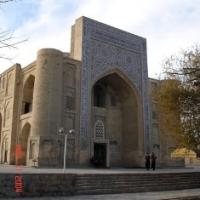You are here
Nadir Divanbegi Madrasah.

Cognitive tours over Bukhara.
“If diversity is a source of wonder, its opposite - the ubiquitous condensation to some blandly amorphous and singulary generic modern culture that takes for granted an impoverished environment - is a source of dismay. There is, indeed, a fire burning over the earth, taking with it plants and animals, cultures, languages, ancient skills and visionary wisdom. Quelling this flame, and re-inventing the poetry of diversity is perhaps the most importent challenge of our times”
Wade Davis.
Park tour in Bukhara.
The building was conceived and built as a caravanserai, and at its opening ceremony it was proclaimed by Imam Kulihan as a madrasah (1622 - 1623). He did not begin to alter in accordance with the new features.
Therefore, the building has no aivans. there is no dome darshana, the role of which was performed by large corner rooms. A wide and high through passage through the portal and the exit to the rear economic yard, characteristic of caravanserais, remained.
Only the main facade was decorated with facing, and the portal timpanas were decorated with images of fantastic flying birds carrying white deer in their claws. The Khanaka and the House were built at the same time and compositionally closely related.
The main facade of the khanaka is beautifully reflected in the water of the house and at the same time serves as a kind of architectural and decorative screen that completes the perspective. For many centuries, a well-shaped portal, woven by majolica girih, was reflected in the mirror of the house.
The Masjidi Kalyan mosque calls the Hungarian dervish Arminius Vamberi to the khanaka, where in the shade of the trees "the actors represent the heroic deeds of famous warriors and prophets, there is never a shortage of crowds of curious listeners and spectators."
The Hanaki building is relatively small, compact, square in plan. two floors high, almost completely hidden behind a high portal. Only above the side facades can be seen a slightly towering dome.
Spacious and high hall opens in the interior. It occupies almost the entire area of the khanaka, small hujras are arranged only in its corner arrays.
Nadir Divanbegi Madrasah is the first construction of the whole Lyabi-Hauz ensemble. This is a massive rectangular structure with cruciform hall under the dome and hudjras in the corners.
Nadir Divanbegi ordered to construct caravanserai on its other side.
At the opening of caravanserai, Imamkulikhan complimented his minister on construction of the building "for the glory of Allah" by advice of Sufi sheikhs. So after that saying, Nadir Divanbegi had to convert this caravanserai into the madrasah.
Nowadays interesting folk concerts of Bukhara masters and defile of modern clothing made of natural materials is organized here inside of the madrasah for tourists and the guests of the city.
Authority:
V.G Saakov «History of Bukhara». Publishing house "Shark", 1996. «Bukhara. Masterpieces of the Central Asia». The historical guidebook across Bukhara. 2012. "Bukhoro. Bukhara" In the Uzbek, English and Russian languages. Publishing house "Uzbekistan", Tashkent 2000. Mukhammad Narkshakhi. History of Bukhara. Tashkent. 1897 (translator N.Lykoshina). V.G.Saakov "Architectural masterpieces of Bukhara. A Bukhara regional society "Kitabhon" Uzbek SSR, Exactly 1991 Robert Almeev. "History of ancient Bukhara". (Under edition of the Academician of the Academy of sciences of Republic Uzbekistan of Rtveladze E.V.)
Photos
Alexander Petrov.







